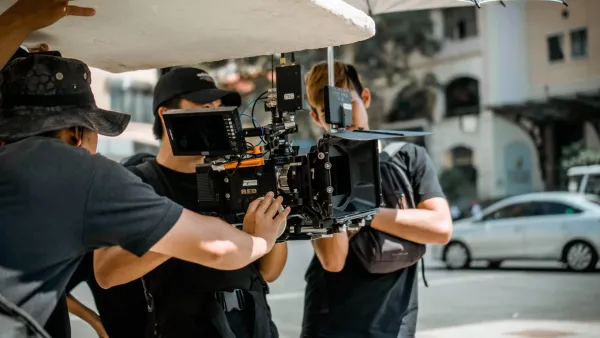How to Make Money with Short Films in 2025

Short films are a creative starting point for many directors, screenwriters, and producers who want to step into the world of cinema. However, whether these creative processes will have financial returns is a frequently asked question: Can money really be made with short films?
The answer: Yes, it's possible with the right strategy and platforms. In this article, we will discuss the ways to generate income from short films and the opportunities offered by Cineshort, one of the prominent platforms in this field.
Film Festivals and Awards
One of the most traditional methods for promoting short films and generating income is film festivals. Awards won at prestigious festivals like Cannes, Sundance, Berlinale, Venice, as well as local and independent festivals, can provide both prestige and financial gain.
Perhaps even more important than financial gain are the network connections that are increasingly formed through festivals. Therefore, you should closely follow festival processes.
Digital Broadcasting Platforms
Today, digital platforms such as YouTube, Vimeo On Demand, Amazon Prime, and Cineshort have become potential revenue sources for short film producers. It's possible to earn regular income from these platforms through advertising revenue, rental, or sales models, according to each platform's broadcasting policies.
Generating Income from Short Films with Cineshort
One of the innovative platforms that stands out for short film producers is Cineshort. This platform enables independent short film producers to upload their projects and reach a wide audience. At the same time, Cineshort supports regular income generation by providing transparent analytics and earnings reports to filmmakers based on content performance.
With these features, Cineshort is not just a broadcasting platform, but also offers an ecosystem that aims for the financial sustainability of creative filmmakers. The more your film communicates with audiences, the more sought-after a producer you become.
Sponsors and Branded Content
Some short films can attract brands' attention and make sponsorship or product placement deals. Short films prepared on themes such as social responsibility, environment, and youth are particularly valuable in this regard.
Crowdfunding and Supporters
Through some crowdfunding platforms, short film producers can earn a monthly income from a loyal audience. You can also implement your projects by collecting campaign-based support.
In short, producing short films has become not only an artistic form of expression, but also a business model that can generate income through the right channels. Thanks to platforms like Cineshort, this process becomes more accessible and sustainable. If you are considering making short films or are already producing projects, you should evaluate these paths. The more original your story is, the greater the success you can achieve with it.
Why Is Making Money with Short Films Important?
Short films are one of the most creative and experimental areas of cinema art. Usually shot with low budgets, limited equipment, and narrow time frames, these films are an important means of expression for young filmmakers. However, most of the time short film producers cannot generate financial gain from their works. Yet making money with short films is of great importance not only individually but also sectorally.
Essential for Sustainable Production
Art production is based on passion, but material resources are also needed for the continuation of production. Generating income from short films allows directors and crews to create resources for new projects. Otherwise, this creative potential may remain incomplete due to economic concerns.
Provides Creative Independence
Independent cinema is where original ideas and different perspectives are brought to the stage. However, remaining independent becomes difficult without financial gain. A short filmmaker who can make money can preserve their own language and artistic identity while producing more freely, staying away from commercial pressures.
Cinema as a Profession
Although short filmmaking is seen as a transition period or portfolio work for many people, it is actually an art form in its own right. The economic recognition of this field ensures that this form of cinema is taken seriously as a profession. Film producers should be able to receive compensation for their efforts so that this field becomes a professional career path.
Power to Attract Investors and Supporters
A short film generating income is not just the success of that producer. It also shows potential investors that short films have a market and audience. This provides a significant advantage in financing larger projects in the future.
Recognition of Cultural and Artistic Value
Making money is not the only measure showing that a job is valuable. But finding economic compensation ensures that short films receive more attention in society. This way, short films become more visible both culturally and artistically.
Short film is not just a "starting point" but a powerful narrative form in its own right. Economic support for this field is critically important for both the development of the cinema sector and the survival of artists. Making money with short films is not just a matter of earnings, but also an investment in the future of cinema art.
Short Film Production and Financial Concerns: Conflict or Balance?
Short film is perhaps one of the cinema genres where originality and creativity are most intensely felt. Short films that capture audiences with simple but impressive narratives without requiring large budgets are a medium where especially young filmmakers can make their voices heard. However, when it comes to short film production, a question inevitably comes to mind: "Don't creativity and financial concerns clash?" Let's search for the answer to this question together.
Art and Money: Mutually Exclusive Concepts?
When we look at art history, many great works have emerged with limited opportunities. This creates the idea that art can exist without money. However, under today's conditions, film production involves costs such as technical equipment, actors, venues, and post-production. This leaves the short filmmaker in the dilemma of "Art or livelihood?"
From Tension to Balance: Solution Ways
This tension is not insurmountable. There are some ways for short filmmakers to cope with financial problems while maintaining artistic production:
- Funds and Support Programs: Ministry of Culture in each country, various film festivals, and international funds can provide financial support to short filmmakers. These supports lighten the burden of production.
- Digital Platforms: Digital platforms like YouTube, Vimeo, Cineshort enable short films to reach wider audiences while also offering copyright or per-view revenue opportunities.
- Collective Production Models: Solidarity among independent short film crews is becoming widespread. Costs can be reduced through equipment sharing, joint productions, and sponsorships.
- Creative Solutions: Financial impossibilities can push the filmmaker to be more creative. Films that take place in a single location, have few characters, and emphasize visual narrative instead of dialogue are examples of this situation.
Can Creative Freedom and Financial Gain Coexist?
Of course. The real issue is for artists to create areas where they can produce without compromising their own values. Thinking sustainability-focused rather than profit-focused becomes important at this point. Because every film can open doors to the next project.
There is a conflict between short film production and financial concerns, yes. But this conflict can be resolved through creative ways and can evolve into balance. As long as artists are not left alone, systems can provide support, and audiences continue to value these productions. Because cinema is the art of not only big-budget films, but also short but effective narratives.
Does Art Lose Its Pure Value When It Starts Making Money?
The answer is both yes and no. Depending on the situation, perspective, and intention, this transformation can be both a threat and an opportunity.
Yes, Its Value Can Decrease. Why?
- Commercial expectation can limit creativity. The pressure to be a "hit" for the audience can distance the artist from their own original language.
- Art can become instrumentalized. If it transforms from conveying messages or emotions to "producing sellable content," it can deviate from its essence.
- Industrialization can factory-ize art. Especially experimental areas like short films can become mundane when they evolve into content serving algorithms or trends.
No, Its Value May Not Decrease. How?
- The artist's labor finds material compensation. Making money doesn't diminish art's value; on the contrary, getting compensation for labor makes it sustainable.
- Independence is strengthened. Financial income allows the artist to focus on production without having to work in other jobs.
- Value and profit don't have to conflict. Art can be commercial, but this doesn't prevent it from being sincere or powerful. Maintaining this balance is in the artist's hands.
The Real Question: "What Does It Serve?"
If art starts being made only to make money, yes, its essence can be damaged. But if art can make money while preserving its value, then why shouldn't it be a commodity?
The real issue is for artists to create areas where they can produce without compromising their own values. Thinking sustainability-focused rather than profit-focused becomes important at this point. Because every film can open doors to the next project.
The Real Danger Is Becoming Superficial
What devalues art is not money; it's moving away from depth, escaping to convenience. The understanding that prioritizes clicks rather than content; the approach that follows trends rather than emotion is the real problem. Money, when used correctly, can make the artist freer and more productive. But when it changes direction and forces the artist to just "be watchable," that's when the danger begins.
Art and money can walk on the same line. What's important is not losing the compass in this walk. Short film, poetry, painting are all labor products on one hand; the voice of emotion on the other. And one of the ways to make this voice heard is to make it sustainable. Art can make money, but if it starts being made only for money, it risks losing its essence. Maintaining this balance is always the artist's responsibility.
Short Film: A Silent Scream Making Social Problems Visible
Short film is not just a cinematic genre; it's also a powerful narrative tool where social issues are voiced. Although it may not reach as wide audiences as feature films or documentaries, short film often creates a more striking, more shocking effect. Because in a short time, it touches the heart directly.
So why is such an effective narrative form often overlooked? The answer is simple: Lack of economic support.
The Camera That Tells Social Realities
Violence against women, refugee problems, class inequality, child labor, nature destruction, invisibility of disabled individuals... These usually pass as a few minutes of "intermission heat" in news bulletins. However, short films transform these realities into a story, a human face, an inner voice. And this makes them unforgettable.
A short film can leave a feeling that is longer than a tweet, more intense than a documentary. Short film is in a very special place for creating social awareness.
But What If There Are No Resources?
Here the fundamental contradiction begins. The area that should make the most noise becomes the least supported area. Short film production still largely depends on volunteerism. Young filmmakers shoot films either with their own means or with very limited funds. Most of the time these films are shown a few times at festivals, then forgotten. However, if these films continued, if these stories reached more people, they could be a powerful tool for social transformation.
Financial Support = Social Memory
A society cannot solve its problems unless it discusses them. Short films are a spark for starting this conversation. But for this spark not to die out, it must be financially supported. Because unsustainable art loses its voice. And if a sensitive and honest medium like short film is buried in silence, the loser is not just the artists, but society itself.
To Be Visible, One Must Live
Short films are not just for viewing; they are thought-provoking, action-inspiring works. For them to have a voice, they need not just to be watched, but to be kept alive. This is only possible with financial support, audience interest, and institutional awareness.
Social change begins with a camera and an idea. But more is needed for continuation. As long as short film producers are supported, we will hear social problems, be disturbed, and produce solutions. Short film production lies at the foundation of all this, and such important work should not be left solely to the personal financial means of short film producers. Producers who have a good idea and want to convey a message should definitely be supported. Thus, sustainability will be ensured.
In Conclusion
Although the starting point for a short film producer is never financial concerns, ultimately, sustainability depends on financial concerns. Receiving compensation for one's labor, creating the necessary fund to start new projects, being a source of motivation - making money from short films is important.
Cineshort is a very important platform that offers you a very important showcase. Short film is a hand that holds up a mirror to society in every aspect. It should be supported and receive the attention and earnings it deserves. Cineshort generously offers this foundation to all short film producers. I invite all of you to join Cineshort's distinguished community. Thank goodness there are short films in our lives.

